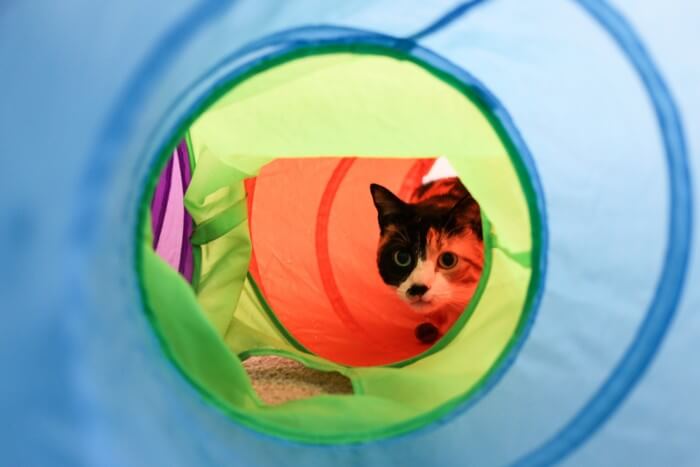Yes – you can walk a cat on a lead.
While not all cats will appreciate the experience there are certain steps you can take to minimise stress and help your cat feel safe and comfortable when on a lead.
As a quick guide here are the key things you should do to successfully take your cat for a walk on a lead:
- Use a cat harness
- Get them used to wearing a lead inside the house
- Walk them in a private enclosed space (like the back garden)
- Keep the walk short (less than ten minutes)
- Follow your cat (don’t pull them where you want to go)
Contents
Is It Cruel To Walk A Cat On A Lead?
Walking a cat on a lead can be cruel depending on how you do it.

The RSPCA does not recommend walking cats on leads because if you walk your cat in the same way that you walk your dog they will have a very stressful experience.
If done incorrectly then walking your cat will expose them to unfamiliar and potentially threatening smells, new and scary experiences such as dogs, loud noises and cars.
Because they are on a lead they will not be able to escape to a place of safety as they normally would which will make the whole experience terrifying and very stressful for them.
However a cat can be walked on a lead successfully if you take certain steps to minimise stress and help them to feel safe.
How To Walk Your Cat With A Lead

To walk a cat properly take these steps:
- Use a cat harness – do not attach your lead to a collar as your cat will not like feeling resistance around their neck and a collar can easily be slipped out of. Use a harness for a more comfortable and secure walking experience. Be aware it may take some time for your cat to get used to wearing a harness once they are used to it they should not wear it permanently as this can cause skin problems.
- Get your cat used to the lead inside – allow your cat time to adjust to the harness and lead. Leave them lying around the house so they get used to the smell, then once they are comfortable with the lead let them wear it and drag it around the house so they get used to the sensation of being on a leash (more on lead training below).
- Walk your cat in the back garden – do not be tempted to take them to a public space where you may encounter cars, dogs, loud noises and other things which may frighten your cat. An enclosed garden space allows your cat to explore in a safe, secure environment.
- Keep the walk short – ten minutes is the longest you should walk your cat on a lead for.
- Follow your cat – when you walk a dog you decide where you are going to go and the dog happily comes along. With a cat you must let them lead and go where they want, pulling them with the lead will cause them stress, they will not enjoy it and they will more than likely run away next time you get the lead and harness out.
Watch Out For Signs Of Stress
Make sure you watch out for any signs of stress in your cats behaviour such as excessive meowing, pacing or trying to run away. If your cat does appear to be stressed take them back indoors and remove the harness as soon as possible.
If you take these steps then it is absolutely possible to enjoy a walk with your cat on a lead without it becoming a cruel or stressful experience.
If you find your cat enjoys walking on a lead then read our article on hiking with cats for information on how to take your walk to the next level.
How to Train Your Cat to Get Used to Wearing a Lead & Harness
Harness & lead training a cat requires a slow and considered approach, don’t expect your cat to be comfortable wearing a harness within one day.

Follow these steps to get your cat comfortable with wearing a harness and lead:
- Before attempting to put the harness on your cat you should first help your cat get used to the harness, leave it near their food, some cat treats or even put a bit of catnip on it. This will help them to associate the harness with positive things while also giving the harness a familiar smell, this will help minimise any stress or uncertainty your cat may feel about the harness.
- Next you want your cat to volunteer to put on the harness, this means you want them to playfully slip their head into it. To encourage this behaviour make the straps extra loose so that there is plenty of room to get their head in, use a treat to encourage them to put their head through if necessary, make sure to reward them.
- The next step is to clip the harness around their belly, at this point some cats may be quite comfortable with you doing this, others may be unwilling. Distract them with treats as you clip the harness up, once they get past the initial fear repeat this until they are comfortable with the procedure.
- Now your cat is wearing the harness, don’t worry about tightening up the straps yet just allow your cat to wander around with it on. The goal is for them to forget they are wearing it. Don’t leave them unattended with it on as it may get caught on something.
- Once they are used to wearing the harness you can tighten the straps up, ensure that there is space for one finger to fit between it and your cat all the way around it.
- Now you can bring out the lead. Some cats will be quite happy for you to attach the lead, others may be more worried by it. If this is the case familiarise your cat with the lead in the same way as you did with the harness (leave it near treats and snacks and allow it to get your cat’s scent on it).
Once you have successfully completed all these steps your cat is ready for a short walk outside!
As an Amazon Associate I may earn a small fee from qualifying purchases at no extra cost to you. This helps us run the site, so thanks for your support!







Leave a Comment